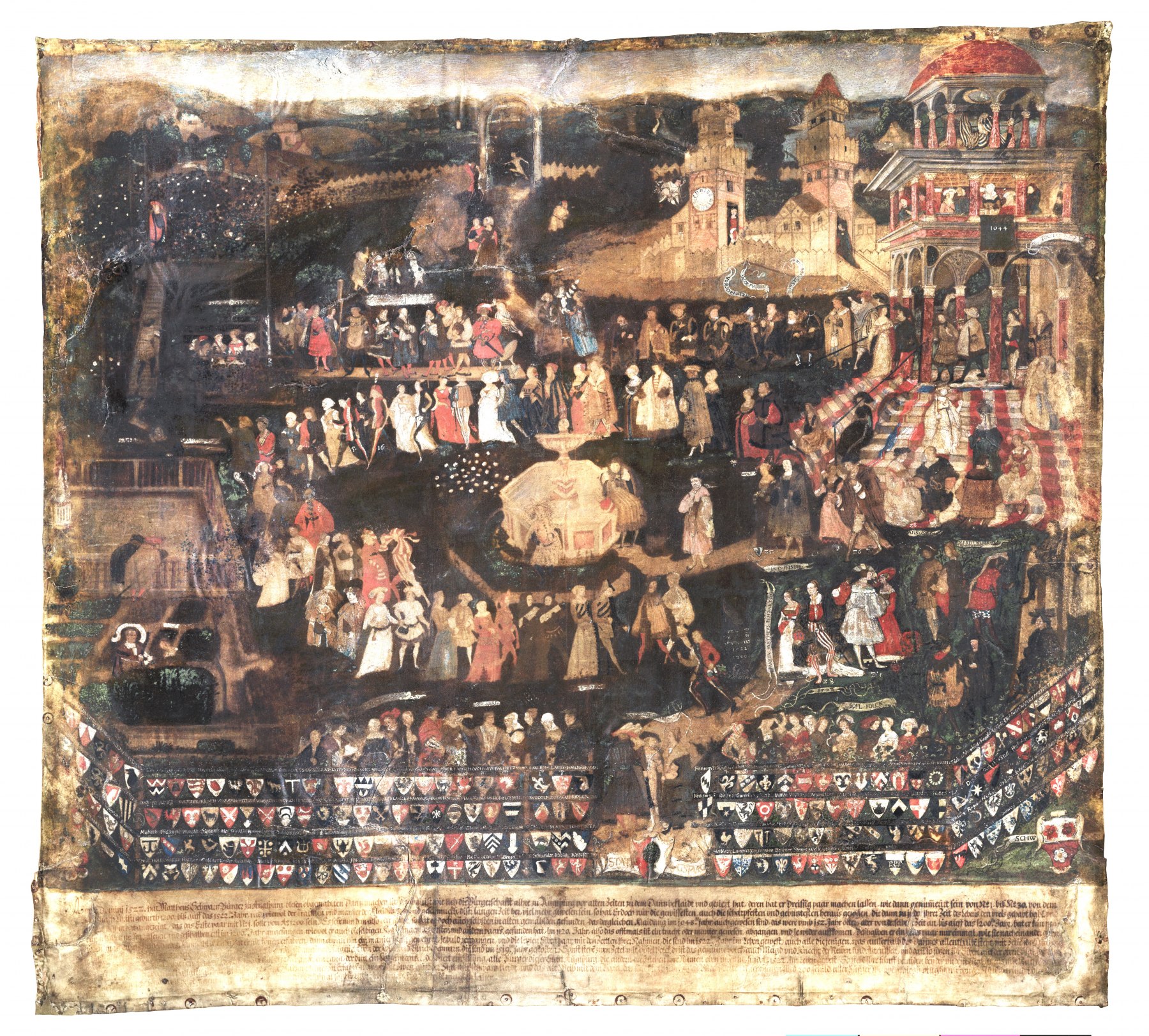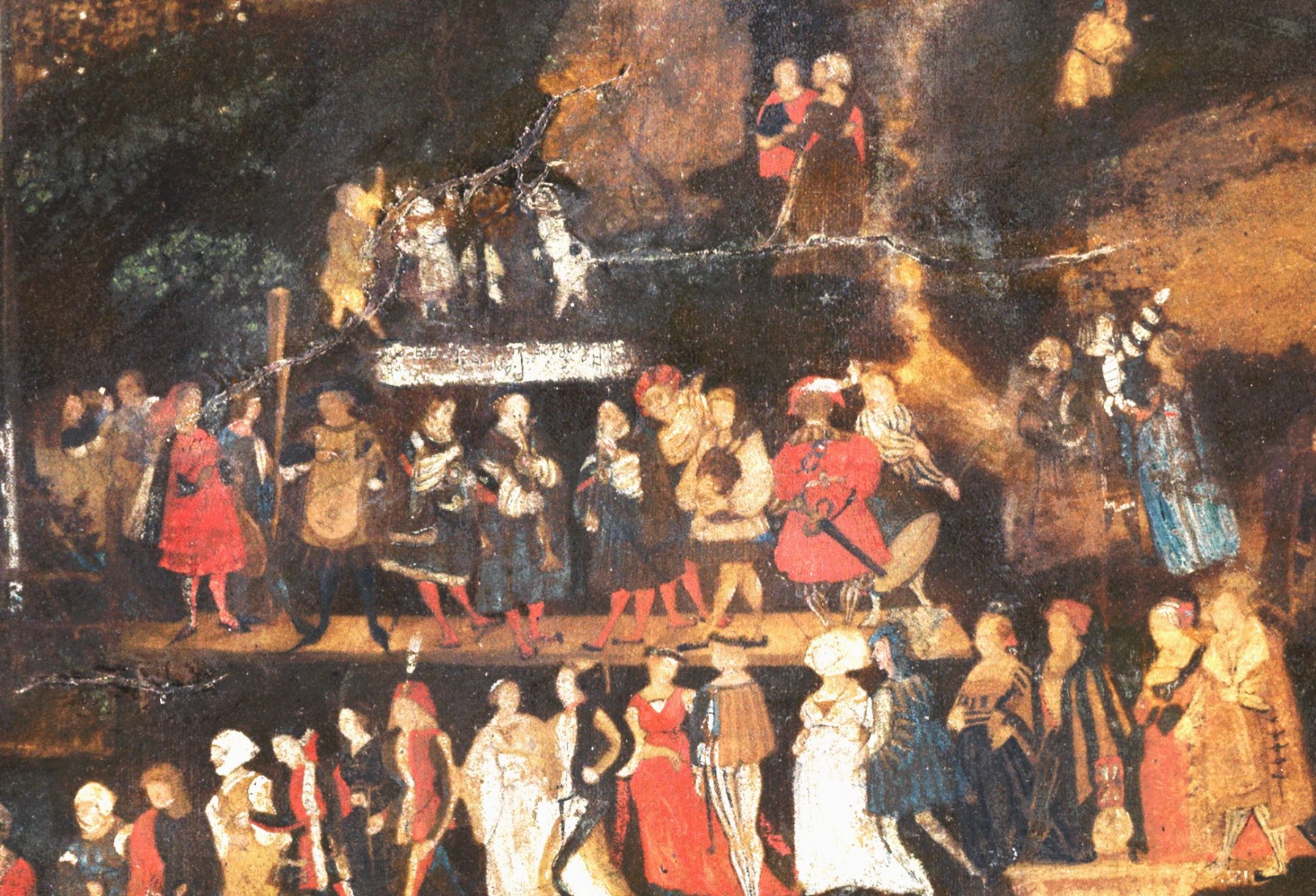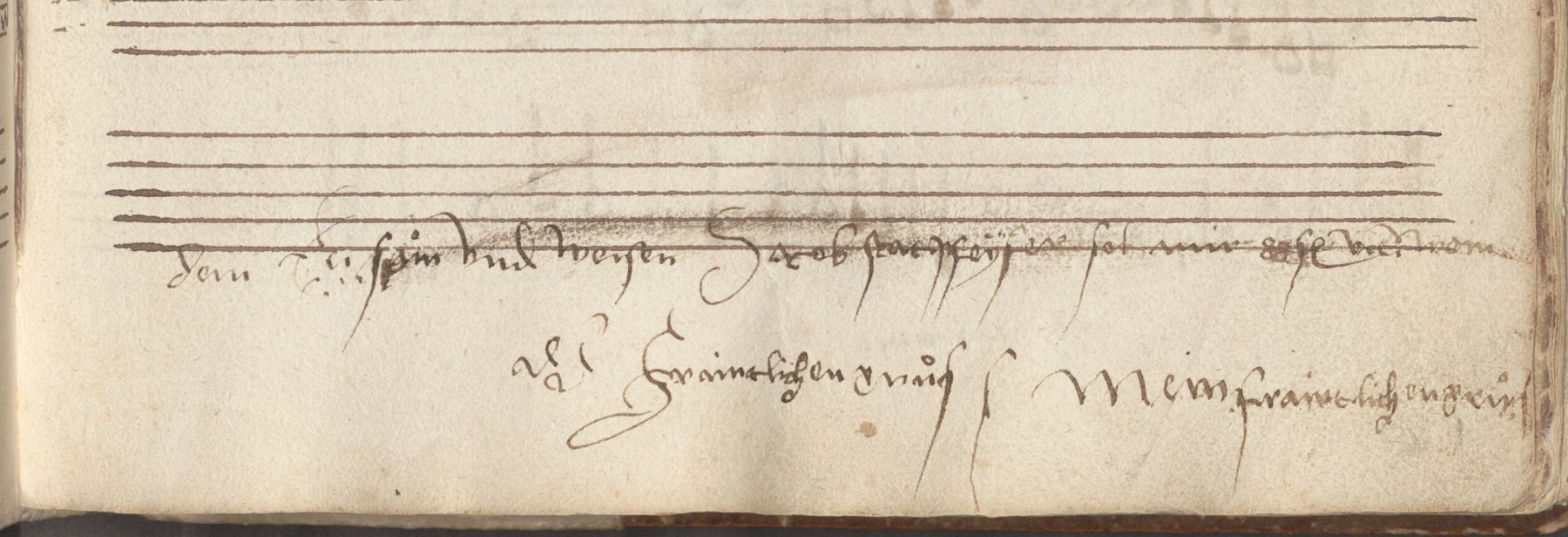Dance Music in the Cities
It was not only the steps of courtly dance that were well-known to the urban elite, but also the repertoire that was associated with these dances. On 8 June 1506, in another letter to Pirckheimer, Behaim, a keen lutenist, remarked on a number of bassadanze that he had in his private music collection, including ‘two bassadanze by Johann Maria … Then the bassadanza by Augustino Trombone, who is in the service of the King of the Romans, and it is quite good and easy. Then there’s another simple bassadanza that can be played on the organ.’[39] Keith Polk and Christian Meyer suggest that ‘Johann Maria’ was a well-known German lutenist then working in Italy, and identify ‘Augustino Trombone’ as the multi-talented lutenist, cornettist and trombonist Augustin Schubinger, a former Stadtpfeifer of Augsburg.[40] A few weeks later, on 29 June, Behaim wrote again to his friend informing him that ‘I am sending you some other bassadanze that I have played; if they please you, copy them and send them back. They are written for 13 strings but you can easily arrange them for 11 strings.’[41] Many dance melodies of the time achieved widespread popularity and were adapted for private performance on instruments such as keyboard and lute. Crawford Young suggests that use of the term ‘bassadanza’ in lute manuscripts of the time refers specifically to settings of the melody known as ‘La Spagna’, i.e. this was the bassadanza melody known to everyone.[42]
This familiarity of the German urban elite with popular dance melodies and the subsequent adaptation of these melodies for private musical practice are also evidenced in music anthologies of the time. For example, the song book assembled by the Nuremberg humanist and patrician Hartmann Schedel completed shortly after his studies in Padua (1463-66), contains, amongst other repertoire, two ‘Carmina ytalica utilia p[ro] coreis’ (‘Italian pieces useful for dancing’), which have in fact been identified as dance tunes of Burgundian origin.[43] Some years later in Basel, the organist Hans Kotter and his colleagues Hans Buchner and Johann Weck compiled a collection of keyboard pieces for Kotter’s pupil Bonifacius Amerbach (whom he taught from c. 1510), which included several settings of dance tenors, four based on ‘La Spagna’. Weck’s setting of the melody (‘Spanyöler Tancz’) is followed by a ‘Hopper dancz’ in halved-note values, similar to the after-dance of a bassa danza or basse danse. Daniel Heartz considers the unusual, syncopated rhythm of the Spagna melody in Weck’s ‘Tancz’ to be a distinctive feature of German adaptations of the later basse danse form, identifying this rhythmic peculiarity in three other dance settings by Weck and Buchner in the Amerbach manuscript (‘Tanz der Schwarz Knab’, ‘Tanzmass Benzenhauer’ and ‘Ein ander Tanz’).
The latter three dances all also appear in Hans Judenkünig’s instruction books for lute printed in Vienna in c.1519 and 1523, each with its own after-dance. In Judenkünig’s settings, the three dance pairs are all given the title ‘Hoftanz’ (‘court dance’). Moreover, both Otto Gombosi and Daniel Heartz have connected this repertoire with the performance of such ‘court dances’ in the German cities. In another lute tablature of the early sixteenth century, D-Mbs Mus. Ms. 1512, a setting of the ‘ander Tanz’ appears with the title ‘Der annder statpfeifer danntz’, therefore associating the melody with its performance for dance in a civic setting. This suggestion is corroborated by pictorial evidence, as identified by Heartz.[44] In Narziss Renner’s painting of a garden dance in Augsburg, dated 1522 (» Abb. Narziss Renner, Gartenfest (1522) and » Abb. Musicians at a civic garden party), behind a procession of patricians whose costumes reflect the transition from the Middle Ages to the year of the painting, there stands a small group of musicians, whose attire and instruments also reflect the chronology represented by the picture.[45] At the centre of this group are three Stadtpfeifer above whose heads a tenor melody can be seen, which Heartz has identified as a setting of ‘Der ander Tanz’ that closely resembles the version in Judenkünig’s publication of 1523. That this melody is identified as both a ‘Hoftanz’ and a ‘Statpfeifer danntz’ reflects the free movement of such dance repertoire between court and urban society.
The shared dance repertoire of city and court is further suggested by another musical source associated with Augsburg, which also alludes to the role of civic and court instrumentalists in the dissemination of dance music: the so-called Augsburg Song Book. This manuscript, which was assembled between 1499 and 1513, contains (along with several vocal pieces) a number of instrumental dances whose Italian origins are reflected in their titles (e.g. ‘La Gambetta: Mantuanner dantz’). Although the early history of the manuscript is unclear – Rainer Birkendorf links its compilation with the Imperial chapel itself — connections with the musicians of Augsburg are in fact evident on one of its pages. As Keith Polk has suggested, a scribbled and obscure note concerning one of the city’s Stadtpfeifer, Jakob Hurlacher, on a page that contains a setting of Dies es laetitae, may possibly indicate his or his colleagues’ role in the transmission of the ‘Mantuan’ or other Italian dances to Augsburg (» Abb. Jakob Hurlacher in the Augsburg Songbook). German instrumentalists were in great favour in Italian cities at that time, and both the aforementioned Augustin Schubinger and his brother Ulrich — predecessors of Hurlacher in the Augsburg Stadtpfeifer ensemble — were employed in Mantua, Ulrich certainly visiting Augsburg from that city at the time that the song book was being compiled.[46]
[39] Translation adapted from Young 2013, 46. Also cited in » H. Kap. Eine süddeutsche Humanistenkorrespondenz (Markus Grassl), with further explanation.
[40] See Meyer 1981, 63-64, Polk 1992, 141-2.
[41] Translation adapted from Young 2013, 47.
[42] Young 2013, 46.
[43] See Heartz 1966, 19-20 and Polk 1992, 135, 139.
[44] Heartz 1966, 20-26.
[45] Habich 1911, 220. For another pictorial document of civic dancing and musicians, see » E. Kap. Musik im Dienst, und » Abb. Patrizierfest.
[46] See Polk 1992, 141; Brinzing 1998, 139-140; Kelber 2018, 136-8. Further on the MS, see » H. Kap. Schubinger und das Augsburger Liederbuch (Markus Grassl).
[1] Unterholzner 2015, 51; Wiesflecker 1971, 372-9.
[2] Annotations on the diary of Reinhart Noltz, Mayor of Worms, in: Boos 1893, 379. Translations of this and the following citations by Helen Coffey, unless stated otherwise.
[3] Neudecker and Preller 1851, 231.
[4] Hegel 1874, 732.
[5] Letter from Barbara Crivelli Stampi to Anna Maria Sforza, Duchess of Ferrara, 24 January 1494. Full transcript in Aigner 2005, 76-7.
[6] Guglielmo di Ebreo claimed that anyone who had studied the exercises in his treatise (1463) would be able to master the dance of any nation. See Nevile 2008, 13.
[7] See note 5.
[8] Amongst the earliest and most significant treatises of the fifteenth century are those prepared by dance masters of the Italian courts, which include Domenico da Piacenza’s De arte saltandi e choreas ducendii (c.1440-50), Antonio Cornazano’s Libro dell’arte del danzare (first version (now lost), 1455; second version, 1465) and Guglielmo Ebreo da Pesaro’s De Pratica Seu Arte Tripudii (1463). French and Burgundian dance practices and repertoire are conveyed in the basse danse manuscript associated with the Burgundian court of Maximilian’s daughter Margaret (now Bibliothèque Royale de Belgique MS 9085, c.1470-1501) and the related printed treatise L’Art et Instruction de Bien Dancer (published in Paris by Michel Toulouze, in or before 1496). For these, and later dance treatises, see Nevile 2004 and Heartz 1958-1963.
[9] See Heartz 1958-1963 and Heartz and Rader 2001a.
[10] See Heartz 1966; Heartz and Rader 2001b.
[11] Heartz 1958-1963, 290; Nevile 2004, 21.
[12] Sparti 1986, 347; Heartz and Rader 2001a.
[13] Aigner 2005, 45-54; Nevile 2004, 26-7. See also Sparti 1986 and Brainard 2001.
[14] Gombosi 1941, 294, 299-300; Heartz 1958-1963; Strohm 1993, 348, 553.
[15] Aigner 2005, 45-54; Nevile 2004, 26-7.
[16] Heartz 1966, 19. A significant use of the melody occurred in the Missa La Spagna by Henricus Isaac: see Mücke-Wiesenfeldt 2012.
[17] Nevile 2004, 2.
[18] Gombosi 1941, 298; Nevile 2004, 1-3.
[19] Gachard 1876, 305-306; for a German translation of the text, see Jungmann 2002, 65-66.
[20] Fucker 1505 (not paginated), quoted in Kelber 2018, 128.
[21] RI XIV,4,1 n. 15882, in: Regesta Imperii Online: http://www.regesta-imperii.de/id/1502-01-09_1_0_14_4_0_49_15882
[22] Kelber 2018, 124-7.
[23] Forthcoming in Regesta Imperii Online.
[24] Franke and Welzel 2013, 34-40.
[25] Leitner 1880-1882, IV.
[26] Leitner 1880-1882, LIII.
[27] Locke 2015, 115, 117-125; Franke and Welzel 2013; Welker 2013; Vignau-Wilberg 1999, 76.
[28] ‘zu frewden seinem volk und zu eren der frembden geest … ist [er] in sonderhait geren in der mumerey gegangen’. See Schultz 1888, 82-4; also Franke and Welzel 2013, 35 and Kelber 2019, 59.
[29] ‘At in aulicorum suorum nupciis conseuit frequenter conmutatis vestibus in gencium aliquarum ritum personatus coram populo saltare. Qua humanitate atque liberalitate sibi multum fauoris tum principum tum populi precipue soeminarum conciliauit.’ See Chmel 1838, 91 for a transcript of the original text; a German translation is presented in Ilgen 1891, 57-8 and quoted in Gstrein 1987, 94.
[30] Barozzi 1880, 216.
[31] Quoted in Kelber 2018, 123-4.
[32] Letter from Mercurino Arborio di Gattinara to Maximilian’s daughter Margaret, 22 November 1507, quoted in Kooperberg 1908, 363.
[33] Heartz and Rader 2001c; Sutton et al. 2001.
[34] Translation from Guthrie and Zorzi 1986, 19.
[35] See Kelber 2019, 66-67; also Schwindt 2018, 83.
[36] Meyer 1981, 64-66, Brainard 1984, Wetzel 1990; also Brinzing 1998, 133-134.
[37] Reicke and Reimann 1940, 439-440 and 496. An English translation of Dürer’s letter is in Fry 1913, 26; Beheim’s letter is translated into French in Meyer 1981, 63.
[38] See Habich 1911, 234; also Kelber 2019, 252.
[39] Translation adapted from Young 2013, 46. Also cited in » H. Kap. Eine süddeutsche Humanistenkorrespondenz (Markus Grassl), with further explanation.
[40] See Meyer 1981, 63-64, Polk 1992, 141-2.
[41] Translation adapted from Young 2013, 47.
[42] Young 2013, 46.
[43] See Heartz 1966, 19-20 and Polk 1992, 135, 139.
[44] Heartz 1966, 20-26.
[45] Habich 1911, 220. For another pictorial document of civic dancing and musicians, see » E. Kap. Musik im Dienst, und » Abb. Patrizierfest.
[46] See Polk 1992, 141; Brinzing 1998, 139-140; Kelber 2018, 136-8. Further on the MS, see » H. Kap. Schubinger und das Augsburger Liederbuch (Markus Grassl).
[47] For an overview of the restrictions see Brunner 1987.
[48] Stiefel 1949, 135.
[49] Brunner 1987, 58-63; Salmen 2001, 165.
[50] Quoted in Polk 1992, 11.
[51] Nuremberg Staatsarchiv, Rep.60a (Ratsverlässe), Nr.259, fol. 5v.
[52] Brunner 1987, 58.
[53] Salmen 1992, 23; see also Salmen 1995.
[54] Vogeleis 1979, 228.
[55] Salmen 2001, 174.
[56] Ernst 1945, 203.
[57] Schwindt 2018, 83-4.
[58] Gstrein 1987, 81.
[59] Polk 1992, 109. See also » E. Musiker in der Stadt (Reinhard Strohm).
[60] On surviving written sources related to Stadtpfeifer and their music (Maastricht fragment and others), see also Strohm 1992; Brown and Polk 2001, 127.
[61] Polk 2003, 98-104; see also, Heartz 1958-1963, 313-316; Heartz and Rader 2001b.
[62] Polk 1992, 161.
[63] Schünemann 1938, 53.
[64] See Welker 2013, 76.
[65] ‘so ließ die künigliche majestat derselben nacht ein tantz auf dem rathaus halten und mancherlei tentz auf welsche und niderlendische art üben und spil treiben, darin auch der kunig persönlich in einem schempart was.’ in: Hegel 1874, 732.
[66] Several references in the records of Nuremberg’s council refer to permission granted for use of the Stadtpfeifer, Stadtknechte and Schützen for the butchers’ annual Shrovetide dance. See, for example, Nuremberg Staatsarchiv, Rep.60b (Ratsbücher), Nr. 4, fol. 156r (1486), fol. 228v (1487), Nr. 5, fol. 4v (1488) and Nr. 6, fol. 2r (1493). For the development of and sources for the Schembartlauf, see Sumberg 1941 and Roller 1965.
[67] ‘Der ro. kinig und sein sun Philipps sind zü pfingsten 1496 hie gewessen. da hat man 10 füder holtz auff den Fronhoff gefiert, und nach ave Maria zeit ain himelsfeur gehebt, und hertzog Philipp und sein adel haben 3 mall um das feur dantzt, und sind da all trumether gewessen, und hand da ob 10000 menschen dantzt.’ in: Roth 1894, 71-72.
[68] Quoted in Kelber 2018, 128.
[69] Donauwörth Stadtarchiv, Johann Knebel, Stadtchronik (unpublished), fo.206v (cited in correspondence from Donauwörth Stadtarchiv).
[70] Quoted in Gstrein 1987, 86.
[71] Gstrein 1987, 88.
[72] ‘sunst ist noch ein Klein peucklin, das haben die frantzosen und niderlender ser zu den Schwegeln gebraucht, und sunderlich zu dantz, oder zu den hochzyten.’ (there is also a small kettledrum, which the French and Netherlanders have often used, above all for dancing or for weddings). Quoted in Gstrein 1987, 91.
[73] Gstrein 1987, 89; Schwindt 2018, 81-2.
[74] Hoffmann-Axthelm 1983, 96. See also Green 2011, 17.
[75] Sumberg 1941, 88.
[76] Translation from Sutton 1967, 39, 47. See also Brunner 1983, 54-5.


